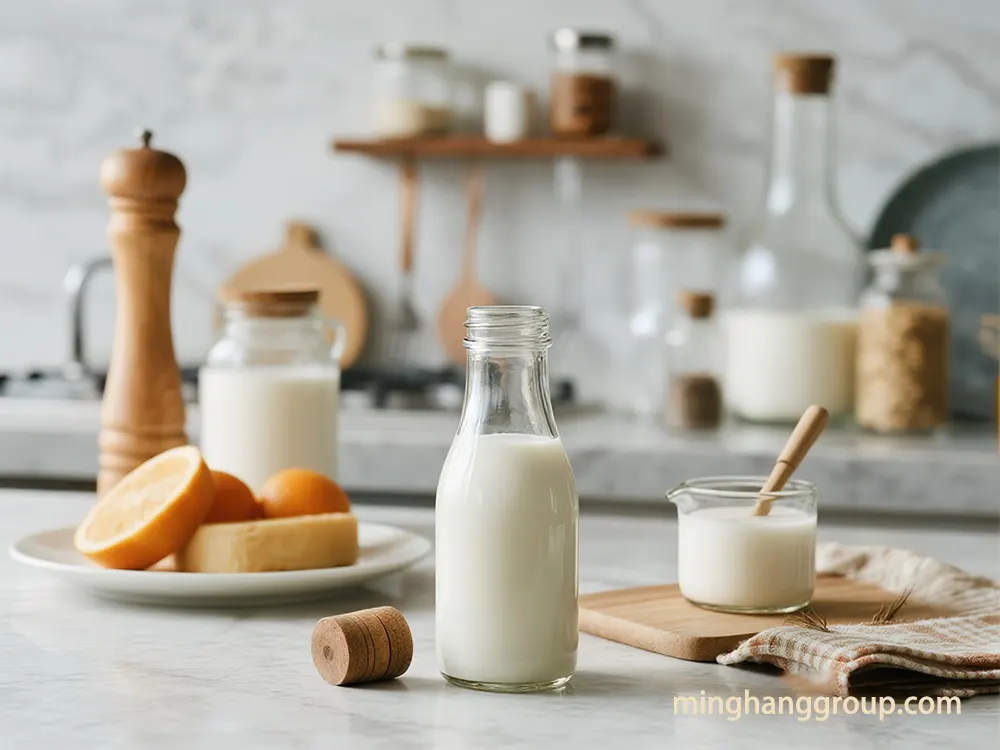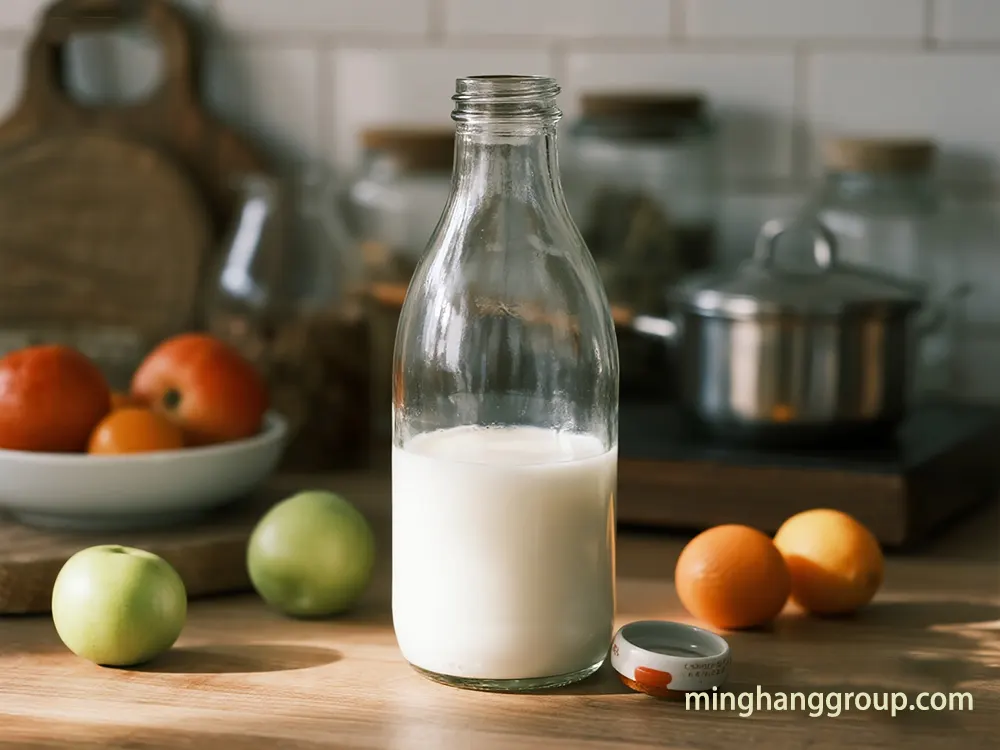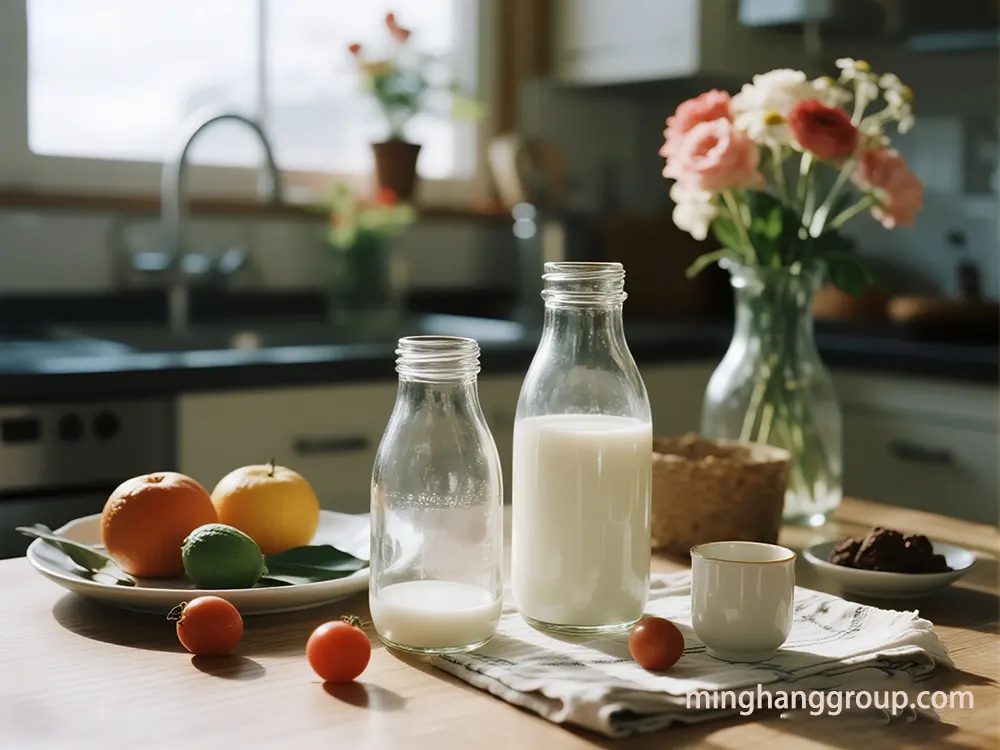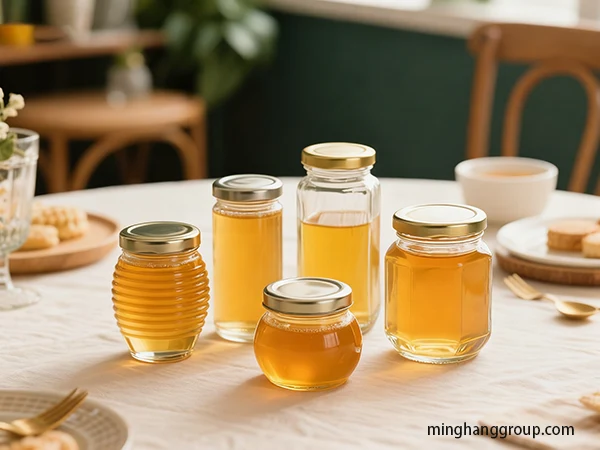Milk producers are using glass milk bottles more and more, which is largely a result of consumer preferences changing, requirements for food safety, and a worldwide call for environmentally friendly packaging. The involvement of the glass milk bottles factory in satisfying these needs is the main subject of this paper. It shows that their production not only guarantees the product’s safety but also helps in gaining the trust of the customers.
The worldwide glass milk bottle market whose value was near $1.5 billion in 2025 is forecasted to close to $2.0 billion by 2033, at a CAGR between 4.5-6.30%. The expansion here signals a market transformation where factors like sustainability, perceived quality, and health matters, in particular, the presence of microplastics, are given more weight.
1. Introduction: Glass Resurgence in Dairy
The comeback of glass milk bottles is more than a mere revival of old times for the dairy industry. It is a redefinition of the industry. Consumers now place product safety, the planet’s health, and realness of the taste above all else. None of the competing beverage packaging materials (plastic and carton ) can answer these concerns more directly than glass.
This report will cover glass’s natural benefits, accuracy in production, contribution to food safety, impact on brand trust, dairy producers’ strategic moves, and the regulatory and innovation environment. The “plastic-free” movement and the rise in awareness of microplastics have been the main drivers behind this comeback with glass being the one that offers “zero microplastic contribution”. The rise in direct-to-consumer (DTC) models and the “milkman renaissance” are also increasing demand with dairies like Danzeisen Dairy experiencing 20% monthly growth.
2. Intrinsic Advantages of Glass for Milk Preservation
Glass has very distinct material characteristics that make it an excellent preservation medium for milk, as it naturally protects quality and keeps the milk fresh for longer periods of time.
2.1. Superior Barrier Properties Against Oxygen and Moisture
The barrier properties of glass are far better than those of plastics such as PET and HDPE. A 30 cm³ bottle, for example, revealed a Moisture Vapor Transmission Rate (WVTR) for glass of 0.07 mg·day⁻¹·bottle⁻¹, which is very much lower than that of PET (9.9 mg·day⁻¹·bottle⁻¹) and HDPE (0.8 mg·day⁻¹·bottle⁻¹).The lack of holes for gases and vapors makes it prevent the oxidation and moisture required for the extension of milk shelf life entirely.
2.2. Inertness and Minimal Chemical Leaching
Glass is a chemically stable and inert material and therefore is ideal for food contact. In contrast to plastics and cartons, it does not release toxic chemicals nor does it give off-flavors, thus preserving milk’s natural taste.The inertness in this case is very important given the issue of microplastics in milk.
2.3. Thermal Stability and Suitability for Heat Treatments
Glass, mainly borosilicate, is very thermally stable and therefore it can be used in the process of milk pasteurization (LTLT, HTST) and sterilization (UHT). With the help of tempering, soda-lime glass, which is the most commonly used glass for bottles, can also become more resistant to thermal shocks and, therefore, it can be allowed to undergo these treatments.
2.4. Different Glass Types and Their Properties
Soda-lime glass is cheap and is the most common type of glass used in bottles because it is easy to work with and is chemically stable.Borosilicate glass is very resistant both thermally and chemically and that is why it is mainly used as laboratory equipment.Milk (pH 6.5-6.8) in general, soda-lime glass is enough.
2.5. Adhesion of Milk Components to Glass Surfaces
The adhesion strength of whole and chocolate milk to glass surfaces is higher than that of reduced-fat or skim milk, therefore, they are more difficult to clean.This has an effect on the efficiency of the “rinse and return” systems which means that the cleaning protocols for different milk types should be optimized.

3. Precision Manufacturing and Quality Control in Glass Milk Bottles Factory
The production of glass milk bottles includes advanced manufacturing and strict quality control measures to maintain structural integrity, cleanliness, and adherence to food safety standards.
3.1. Advanced Forming Techniques Used by Modern Glass Milk Bottles Factory
Contemporary glass production mainly relies on the blow-and-blow, press-and-blow, and narrow neck press-and-blow (NNPB) techniques.NNPB is the most significant development, as it allows for better glass spreading, lower bottle weight, and high-volume production of light-weighted milk bottles.
3.2. Automated Inspection Systems with Vision AI and Deep Learning
Industries nowadays rely on automation with the help of Computer Vision AI and Deep Learning for the detection of defects as they happen.The machines take the highest quality pictures from different viewpoints, identifying and categorizing the defects like bubbles, scratches, and cracks with an accuracy of more than 99%, and thus, facilitating traceability and record keeping.
3.3. Energy Efficiency Innovations in Glass Furnaces
Contemporary glass furnaces are equipped with regenerative heat exchangers, optimized fuel usage (e.g., oxy-fuel), and are fully electric to reduce energy consumption and emissions.Fully electric furnaces are capable of using 35% less energy than typical fossil fuel heating.
3.4. Integration of Recycled Cullet for Sustainability and Efficiency
Using recycled glass (cullet) is an essential part of environmentally friendly production that is energy-saving to a great extent (e.g., 40% less energy is required for 100% PCR glass) and at the same time helps to lower the use of raw materials and CO2 emissions.The problem of contamination and transportation is solved by advanced methods of sorting and crushing.
3.5. Comprehensive Quality Assurance Standards and Certifications
The industry implements tough standardization such as ISO 9001 (Quality), ISO 14001 (Environmental), ISO 50001 (Energy), and BRCGS Global Standard for Packaging, that, among other things, provide consumer trust in the quality of the products, environmentally friendly production, and packaging safe for consumer health.
3.6. Surface Treatments for Enhanced Durability and Hygiene
Glass containers are subjected to hot (tin oxide-based) and cold surface treatment for protection from wear, conservation of strength, lower breakage, and the supply of hygienic surfaces during handling and transportation.
3.7. AI for Predictive Maintenance and Process Optimization
Artificial intelligence and machine learning are utilized in production facilities for predictive maintenance and process optimization.AI looks at hundreds of parameters to foresee breakdowns, get the maximum output, decrease the length of the work cycle, and lower the times when the machine is idle and scrap rates.
3.8. Leading Manufacturers' Commitment to Sustainability and Innovation
The likes of Ardagh Group and Verallia are embracing changes and going green by among other things, inventing the hybrid electric furnaces and utilizing 100% PCR glass.MINGHANG is a custom builder that uses the in-house mold design and flexible production to comply with the strict food safety standard and short turnaround times.
3.9. Digitalization and Automation for Enhanced Production Control
The glass sector has embraced digital technology and automation to the fullest, where even raw material transport, melting, shaping, and cooling are done without human intervention.The advantages of this are increased output, reduced labor costs, and the possibilities for continuous learning and optimizing by AI.
4. Enhancing Food Safety: Glass as a Protective Barrier
Glass packaging plays a key role in the food safety of dairy products by limiting chemical migration, microbial contamination, and oxidation.
4.1. Superior Light Barrier and Prevention of Light-Induced Off-Flavors (LIOFs)
Among various packaging materials, glass gives the best protection to milk against ultraviolet (UV) radiation, thus preventing light-induced off-flavors (LIOFs) which result from the oxidation of lipids and the degradation of amino acids. Naturally occurring essential nutrients in milk are destroyed at a fast rate. For instance, vitamins A, D, and riboflavin are depleted within a mere two hours, and the off-flavor formation process can take as little as 15 minutes.
4.2. Impact of Light on Multiple Vitamins and Proteins
Exposure to light strongly destabilizes the nutritional profile of milk and simultaneously, ridoflavin, B12, A, and D undergo a drastic decrease in content due to light exposure. Besides this, protein oxidation occurs giving rise to the so-called “sunlight flavor” and further milk wastage that can be avoided if the products are well protected from light. Clear PET provides the least amount of protection, therefore, the most significant losses in terms of vitamins take place in comparison to HDPE or paperboard coated with protective layers.
4.3. Efficacy of Amber Glass in UV Protection
Because amber glass can absorb nearly 99% of UV-A and UV-B radiation, it is very effective in light shielding of photosensitive materials such as milk. Besides nutrients preservation, the product’s integrity is also ensured.
4.4. Glass Preserves Flavor and Prevents Chemical Migration
An investigation made in the year 2023 pinpointed glass as the most beneficial material for the conservation of milk’s original flavor. Whereas porous cartons and plastic pouches are vulnerable to flavor migration and “refrigerator taint,” glass being a non-porous and inert material does not allow for chemical transfers and thus helps in keeping the taste pure.
4.5. Temperature Retention and Shelf-Life Extension
Compared with plastic, glass containers are capable of keeping the milk temperature for a longer time which is very important when we talk about the cold chain maintenance, as well as freshness and safety extension of the product.
4.6. Microbial Contamination and Sterility Maintenance
Although the microbial population on the glass surface is minimal, the design of the primary packaging and the integrity of the container closure (CCI) play a major role in the sterility of the products thereby, preventing the entry of microbes and the recall of the product. Proper light shielding is more important than oxygen barriers when it comes to the prevention of light-induced oxidation during storage over long periods.
4.7. Smart Packaging for Enhanced Monitoring
One feature of smart packaging is the presence of Time-Temperature Indicators (TTIs), freshness sensors, and biosensors, all of which can detect changes in milk that is indicative of healthiness and provide that information in real-time thus, making the assessment of freshness more accurate and being in line with glass’s protective characteristics.
4.8. Microbial Challenge Studies for Food Safety and Shelf-Life
Microbial challenge studies are the basis for acquiring knowledge on the behavior of microorganisms in shelf-life food products. These studies can unveil both intrinsic and extrinsic factors responsible for the inhibition of growth as well as factors that guarantee safety.

5. Cultivating Brand Trust: Consumer Perception and Premiumization
Glass bottles play a major role in how consumers perceive a brand, thus creating brand trust and allowing a premium market position by dairy producers.
5.1. Premium Perception and Perceived Value
Glass packaging is construed as a luxury one and thus is attributed with higher value just because of the factors such as its weight and cool suffering which in turn is said to facilitate the whole concept of refreshment and thereby help in the justification of the higher price points.
5.2. Trust and Authenticity through Transparency
One of the factors that enhance brand trust is the use of glass by brands because it is transparent and thus the customers can visually check the product. Thus connecting glass with authenticity, naturalness, and less processed products as the most preferred packaging for organic and specialty brands.
5.3. Sustainability as a Key Driver for Purchase and Premium Willingness
Environmentally aware consumers, mainly from Europe and North America, are demanding eco-friendly packaging.Glass is leading a good example by being reusable and recyclable , and as a result, it is a source of higher purchase intentions and great willingness to pay a hefty premium (up to 20% more, while one research discloses a 59.78 cent premium for returnable glass).
5.4. Emotional Connection and Brand Loyalty
Producers of glass containers remind us of tradition, heritage, and purity, which are major emotional connections that people have.Refillable arrangements become the vehicle for continuing relationships and brand loyalty. The return of nostalgia for traditional milkman deliveries is also one of the reasons behind this.
5.5. Impact on Purchase Intent and Repeat Purchases
Packaging significantly impacts a consumer’s decision-making process, perception, and purchase intention.The positive relationship of effective packaging with brand choice and repeat purchases results in higher recognition and sales.
5.6. Cross-Cultural Variations in Perception and Preference
The cultural differences in the perception of dairy packaging can be attributed to various factors such as climate, lifestyle, and economy. The cultural familiarity factor plays an essential role in consumer design preference, as global consumers incline towards the ones that resemble their home regions.
5.7. Strategic Role of Packaging Design Elements
Visual parts such as the shape of the bottle, the label, the color, and the type of printing got more weight and influence in buying decisions than the material used for the packaging. Consumers may be attracted to a brand because of its unique bottle shape, specific curves, or embossing designed to separate the brand from others while the color of a product packaging appeals to the consumers emotions.Lorem ipsum dolor sit amet, consectetur adipiscing elit. Ut elit tellus, luctus nec ullamcorper mattis, pulvinar dapibus leo.
5.8. Social Media Sentiment as a Gauge of Public Opinion
Social media is full of information about the consumers’ assessment of package attributes. By analyzing such communication, the company can spot the positives and negatives (e.g., less portable comments for glass), thus informing design decisions and consumer demand alignment practices.
5.9. Functionality and Convenience in Packaging Design
Functionality features such as a product’s easy grabbing, pouring, and reusability are greatly responsible for consumer delight to a large extent. Convenience-centric products have become highly acceptable in the modern-day fast life world where there is a need to strike a perfect balance between a traditional and modern lifestyle.
6. Strategic Considerations for Dairy Producers: Operations and Market Impact
The utilization of glass packaging leads to difficulties in operations, however, generally results in strategic benefits in the long term for dairy producers.
6.1. Resurgence and Consumer Preference for Glass
One of the major strategic advantages is the intense consumer demand for glass, which is primarily responsible for the good image of the product in terms of quality, taste, and even respect for the environment. Danzeisen Dairy, for instance, experienced a 20% growth on a monthly basis, while Milk & More reported that 90% of new customers chose glass.
6.2. Higher Initial Capital Investment for Filling Lines
The change to glass provokes a need for a considerable amount of money prior to the change for a specially designed and required equipment in an already existing filling line that is modified by advanced hygienic and safer milk fillers.
6.3. Increased Transportation Costs and Environmental Footprint due to Weight
They are significantly heavier than their plastic counterparts and as a result, glass bottles may face issues with transportation costs and carbon emissions. In order to be environmentally relevant, a returnable glass system should operate within the local supply chain, and its transportation distance should not exceed 250 km.
6.4. Logistical Complexity of Returnable Systems
The implementation of a returnable glass system requires the reverse logistics infrastructure to be well-established and capable of handling the stages after collection, such as sorting, washing, sanitization, container inspection, and specialized decontamination procedures.
6.5. Breakage Risk and Insurance Implications
Glass bottles can break when they are in a transport or are being handled thus, resulting in a company losing money and in delays. They can be insured though, and regular claim filing can lead to increased premium rates. The implementation of proper techniques in the design of packaging and cushioning can considerably lessen breakage rates.
6.6. Total Cost of Ownership (TCO) Dynamics
However, plastic is cheaper to manufacture initially than glass, cumulative costs over many refill/reuse cycles may be more favorable due to the latter’s durability and unlimited recyclability. What is more, plastic also entails hidden long-term environmental and health costs.
6.7. Automation as a Mitigation Strategy
Handling of glass bottles in an efficient way is impossible without the help of advanced automation, which includes robotics and machine vision. Stocks for depalletizing, filling and capping are automated and thereby labor costs are mitigated, efficiency improved and hygiene ensured.
6.8. Brand Image and Premium Market Positioning
Due to the premium and environmentally friendly nature of the product, glass packaging enables dairies to charge higher prices and increase their brand value. A French dairy experienced a 22% increase in sales after the adoption of tailor-made glass bottles.
6.9. Sustainability and Circular Economy Contribution
The use of glass bottles that can be refilled 30 or more times, on average, is a significant step towards the reduction of waste and the implementation of a circular economy. According to research, a minimum of 8 use cycles is required for the environmental impact to be comparable to that of PET.
6.10. Challenges in Customization and Supply Chain Agility
Glass bottle manufacturers of unique designs may find it difficult to convince suppliers to agree on their small batch orders. Nevertheless, a specialized manufacturer such as MINGHANG has an advantage with in-house mold design and production lines that are not rigid and can easily change for different products.

7. Regulatory Landscape and Future Innovations
The regulatory environment combined with advances in technology forms the basis of glass’s future in the packaging of dairy products, where emphasis is on safety, sustainability, and usability.
7.1. Current Regulatory Landscape
- FDA Regulations for Food Contact Materials (FCMs):The FDA is in charge of glass regulation as a contact food material and is primarily concerned with the safety, durability, and compatibility of the material. It is also stipulated that coatings and recycled glass be as safe as their virgin counterparts, and this usually calls for FCN and GMP compliance to be met.
- EU Regulatory Framework for FCMs:In the European Union, glass is governed by the Framework Regulation (EC) 1935/2004, which sets out the general safety requirements. However, even though glass is a passive material, the absence of a thoroughly harmonized EU-level regulation results in differences between the national requirements and thus increased costs for compliance.
- Environmental Policies Driving Glass Packaging Adoption:The rising backlash against plastic waste has become one of the major reasons for the accelerated transition to glass as a recyclable and reusable material. Few examples of the DRS and EPR schemes effects are the incentives for the return and reuse of goods, thus attaining high recovery rates.
- Key Sustainability Certifications for Glass Packaging:The leading certifications contain Cradle to Cradle Certified™ (O-I secured PLATINUM for material health), EcoVadis, ISO 14001, and Recycled Standard Certification (RCS). Stanpac is also certified by SFI® and the FDA “GRAS”.
7.2. Future Technological Innovations
- Ultra-Lightweight Glass Development:Extremely light glass containers are made possible through innovations like NNPB technology and high-strength formulations. Some of the examples are Vetropack’s Echovai that is almost a third lighter resulting in 25% less carbon and Verallia’s Ecova range. This helps to lessen the transport cost as well as the carbon footprint while still maintaining the product’s durability.
- Advanced Protective Coatings for Enhanced Functionality:There are new clear coating materials (e.g., TiO2, organic silicon resin) that allow for UV protection without changing the look of the product. These functional coatings may also have properties such as anti-microbial, anti-fingerprint, and scratch-resistant, thus enhancing security as well as the consumer’s experience. To a large extent, amber and black glass can be regarded as strong UV protectors.
- Smart Packaging Features for Traceability and Consumer Engagement:By using QR codes, RFID, and NFC tags, stakeholders can get real-time updates on the location of the product, managing inventory, and verifying authenticity. They can also create new ways of customer interaction. Although implemented in the dairy industry on a small scale due to the high costs of each unit, this technology widely cannot be used yet.
- Novel and Efficient Glass Recycling Processes:Glass is recyclable to a full extent and an unlimited number of times. Recycling involves the stages of collection, color sorting, impurity removal, crushing to get cullet, melting, and reshaping. The innovations are about utilizing the recycled cullet in building and producing porous glass for the environmental sector.
- Materials Science Impact on Glass Composition:With the help of nanotechnology glass components in the future can become better barriers towards oxygen, moisture, and UV light, or they can have other features, thus leading to properties that are specifically tailored for dairy products.
- Blockchain for Enhanced Dairy Supply Chain Transparency:By recording every single step from the farm to the refrigerator and not allowing modification, blockchain can totally change the way dairy supply works. Different solutions there would help to keep track of the origins, safety, and processing of milk, as well as its distribution, thus tackling the food safety issue together with counterfeiting problems. Among the difficulties, there are high costs for the implementation and complex technical matters.
8. Conclusion: A Holistic View of Glass in Dairy's Future
The rise of glass in the packaging of milk products shows the remaining importance of this material. Glass milk bottle factories are imperative as they provide first-hand benefits in the preservation of milk through better barrier properties, inertness, and thermal stability. High precision is achieved through advanced forming, AI-driven inspection, and energy-efficient furnaces in manufacturing. Along with MINGHANG as an innovative player, these factories commit food safety by lessening contamination and oxidation, at the same time, through premium perception, transparency, and sustainability alignment, they increase brand trust.
The higher initial investment, increased transportation costs, and more complicated logistics are some of the operational challenges that have been overcome through methods like automation, innovations in lightweighting, and advanced coatings. An ever-changing regulatory framework that pays attention to environmental policies and sustainability certifications is a good additional argument for glass usage. What is more, innovations in materials science, smart packaging, and blockchain will soon be able to deliver even more benefits in terms of functionality, traceability, and sustainability. Glass milk bottle factories are the most important facilitators of a clean, fresh milk supply chain that is delivered with integrity and trust, thus satisfying contemporary consumer demands.




